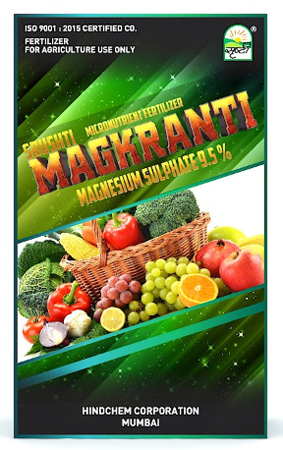
MAGKARANTI Technically, magnesium is a metallic chemical element which is vital for human and plant Life. Magnesium is one of Magnesium is one of thirteen mineral nutrients that come from soil ,and when dissolved in water ,is absorbed through the plants roots. Sometimes there are not enough mineral nutrients in soil and it is necessary to fertilize in order to replenish these elements and provide additional magnesium for plants.
How do plants Use Magnesium?
Magnesium is the powerhouse behind photosynthesis in plants. Without magnesium, chlorophyll cannot capture sun energy needed for photosynthesis .In short, magnesium is required to give leaves their green colour .Magnesium in plants is located in the enzymes, in the heart of the chlorophyll molecule. Magnesium is also used by plants for the metabolism of carbohydrates and in the cell membrane stabilization.
Magnesium Deficiency in plants the role of magnesium is vital to plant growth and health .Magnesium deficiency in plats is common where soil is not rich in organic matter organic matter or is very light .Heavy rain can cause a deficiency to occur by leaching magnesium out of stand or acidic soil. In addition, if soil contains high amounts of potassium plants may absorb this instead of magnesium, leading to a deficiency.
Plants that are suffering from a lack of magnesium will display identifiable characteristics. Magnesium deficiency appears on older leaves first as they become yellow between the veins and around the edges. Purple, red or brown may also appear on the leaves. Eventually, if left unchecked, the leaf and the plant will die.
Providing Magnesium for plants providing magnesium for plants begins with annual applications of rich ,organic compost .Compost conserves moisture and helps keep nutrients form leaching out during heavy rainfall. Organic compost is also rich in magnesium and will provide an abundant source for plants. Chemical leaf sprays are also used as a temporary solution to provide magnesium
Manufacturing
- Roots Gold (Mycorrhizae)
- Pota Rise (Mycorrhizae)
- Maagnet PROM (Phosphate Rich Organic Manure)
- NPK 19.19.19
- NPK 13.00.45
- NPK 12.61.00
- NPK 00.52.34 Mono Potassium Phosphate
- 00.00.50 Sulphate of Patash
- Calcium Nitrate: N15.5%, CA18.8%
- Phose Up
- Liquid Zinc
- FERROUS EDTA
- Lemon Zinc 12%
- BORON
- MAGKARANTI
- IRON
- SUPER FIX
- S SARDAR G
- S SARDAR-G LIQUID
- BLACK DIAMOND 98
- FUTARA
- JAVA PREMIUM
- LIQUID POTASH